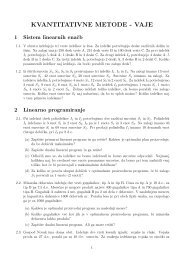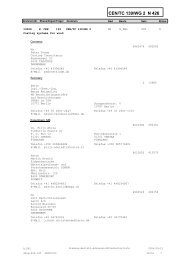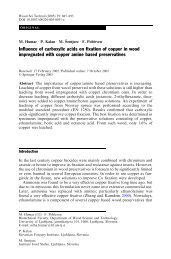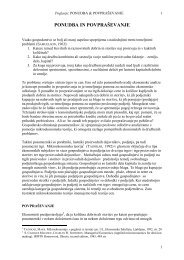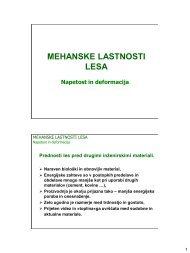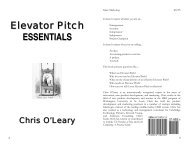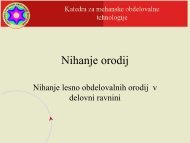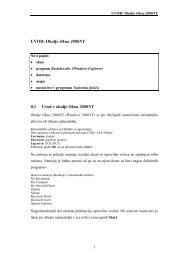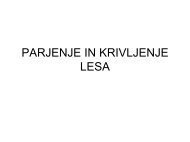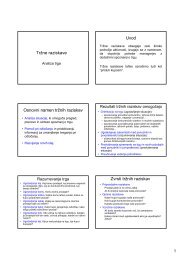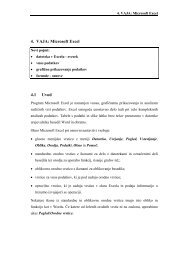Title of paper (Use 14 pt Arial bold)
Title of paper (Use 14 pt Arial bold)
Title of paper (Use 14 pt Arial bold)
- No tags were found...
Create successful ePaper yourself
Turn your PDF publications into a flip-book with our unique Google optimized e-Paper software.
„Hardwood Science and Technology”The 4th Conference on Hardwood Research and Utilisation in Europe 2010Solid wood can be liquefied using different solvent systems. The first system uses phenols(ALMA AND BASTÜRK, 2006), whereas the second employs cyclic carbonates (XIE AND CHEN,2005), the third uses ionic liquids (HONGLU AND TIEJUN, 2006), the fourth introduces dibasicesters without hydroxyl groups (WEI ET AL., 2004), and the fifth system is based on polyhydricalcohols. Solid wood liquefied with polyhydric alcohols contains enough -OH groups, which canpotentially react with the PF resin, and take part in the adhesive mixture as a copolymer (BUDIJAET AL., 2009). The objective <strong>of</strong> this study was to determine the bond performance <strong>of</strong> specimensfrom beech wood bonded with an adhesive mixture made <strong>of</strong> liquefied wood and phenolic resin.EXPERIMENTAL METHODSSawdust (fractions 0,237 mm or smaller) <strong>of</strong> the black poplar (Populus nigra L.) was used for theproduction <strong>of</strong> liquefied wood (LW). Prior to the liquefaction process, the sawdust was dried in alaboratory oven (103 °C, 24 h). Glycerol (GLY) (p.a. grade, Kemika, Croatia) was used as thereaction reagent, and sulphuric acid (SA) (p.a. grade, Sigma Aldrich, Germany) was used as acatalyst. The mass ratio between the black poplar sawdust and the GLY was 1:3 (150 g <strong>of</strong>sawdust and 450 g <strong>of</strong> GLY), and 3 % <strong>of</strong> SA, based on the GLY content, was added (13,5 g). Theliquefaction reaction was performed for 90 minutes in a glass laboratory reactor, which wasimmersed in an oil bath that had been preheated to 180 °C. After reaction, the reactor wasimmersed in cold water in order to quench the reaction. The liquefied product was then dilutedwith a mixture <strong>of</strong> 1,4-dioxane and water (4/1, v/v) and filtered through filter disks (Sartoriusfilter disks 388 grade/84/mm 2 ) to remove the insoluble parts <strong>of</strong> the wood. After filtration, themixture <strong>of</strong> 1,4-dioxane and water was evaporated under reduced pressure, obtained by using awater pump, in order to obtain the liquefied wood containing GLY.The adhesive mixtures were prepared according to Table 1. A commercially available syntheticPF adhesive (Fenolit d.d., Slovenia) was used to prepare the different PF-LW adhesive mixtures.Table 1: Preparation <strong>of</strong> the adhesive mixturesAdhesive mixture Weight portion <strong>of</strong> PF adhesive [%] Weight portion <strong>of</strong> LW [%]1 100 02 75 253 50 504 25 755 0 100Prior to bonding, all <strong>of</strong> the beech wood lamellas were planed in order to ensure a smooth and flatsurface. The two lamellas were then bonded together with the different adhesive mixtures (Table1). The adhesive mixtures were applied with a roller, using an application rate <strong>of</strong> 200 g/m 2 . Thepress temperature was 180 °C, and the pressure was 1 MPa. In the first part <strong>of</strong> experiment thepress time was 600 seconds for all the adhesive mixtures, whereas in the second part the presstime was ada<strong>pt</strong>ed to the used adhesive mixtures (Table 2). The press times used in the secondpart <strong>of</strong> the experiment were determined on the basis <strong>of</strong> preliminary rheological measurements <strong>of</strong>the adhesive mixtures.



